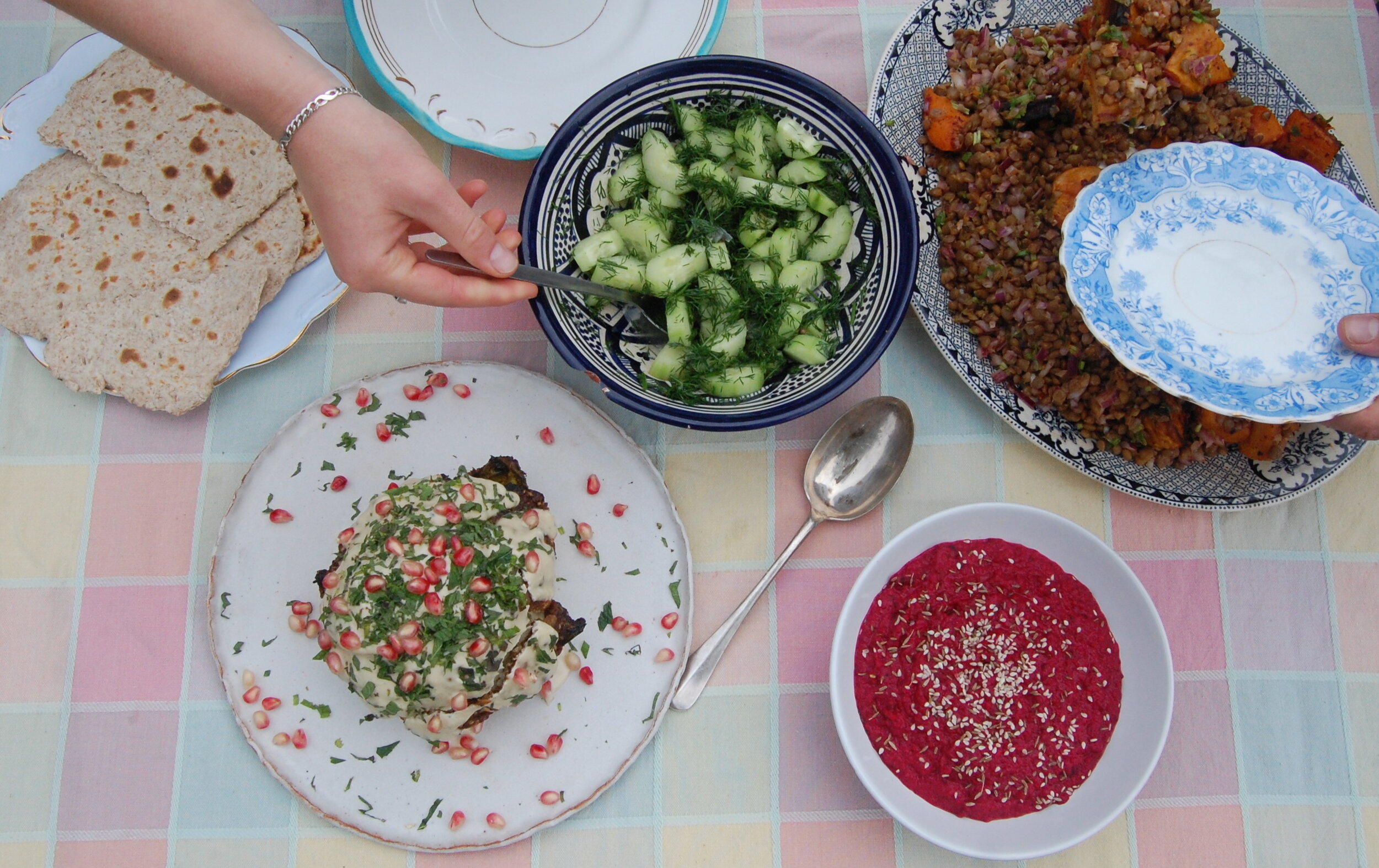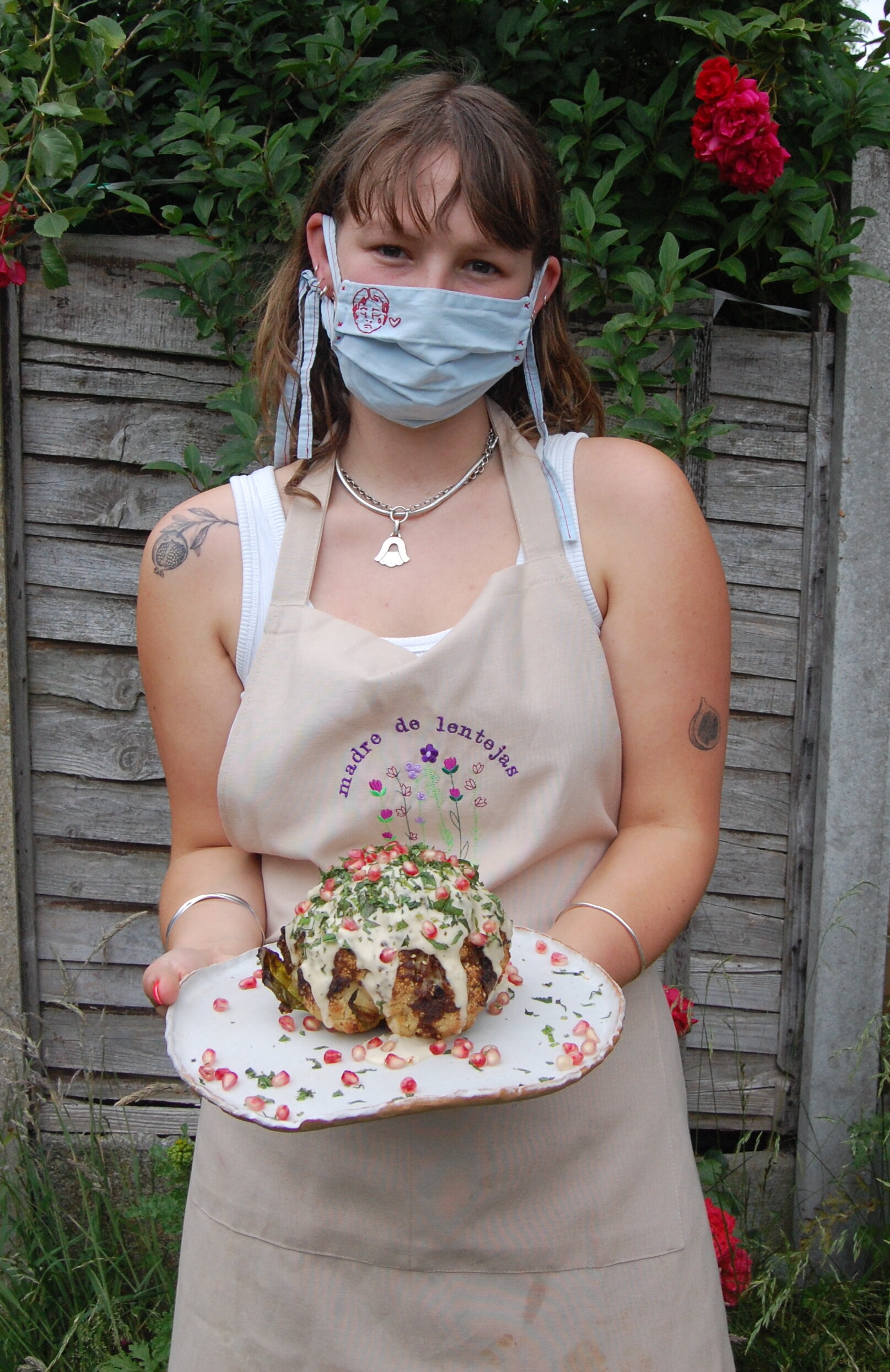The Kitchen Table
The Kitchen Table
Lily Chappell
Artwork by Ella Bracey
A focal point. Often piled with bills, pens, scribbled shopping lists, an occasional laptop, charger, discarded shopping bag, a bowl of fruit – during the day it becomes a dumping ground for things that are no longer needed, things that overflow from our arms and don’t quite make it where they need to go. They stay there for most of the day, softly accumulating or being carried from one room to another before someone loses their train of thought and puts them down again.
In the evening everything gets piled together and moved out of the way, gloves returned to the basket by the front door, shoes pulled out from underneath the table and moved to the hallway, pens placed back in their pots. The table is wiped down and laid. Often, whilst I cook dinner for my family, smells or sounds draw them down and they stick their heads in for a chat,
‘How was your day?’
‘Alright, yeah.’
‘Smells good!’
‘Is there anything I can do to help?’
They go about their business again, until I bring them back downstairs with a shout. There is a sudden rush as everyone finds their seats, fetching forgotten glasses of water and helping bring dishes and pans from the side. We chat as they start to help themselves and I explain what’s being served. As we begin to eat there is often a momentary hush, but this never lasts for long.
My favourite moments are those when we sit back, stomachs full, and chat. During lockdown this was some of the only time we spent together as a family, and it felt important to embark on those long, quiet evenings together, at least for a bit.
It is during these moments that I have reached for my mum’s hand over the table to give it a squeeze, her shoulders tired as she recounts the stress and sadness of working in the NHS. We have teased my brothers about their hair, so long that it’s getting in their eyes, begging them to let me shave it all off. I’ve teared up when I’ve talked about how long it’s been since I last saw our grandparents in real life.
Christmas 2019.
I remember bending over laughing at the sight of my granny wearing a fuzzy grey moustache and a green paper crown that she’d got in a cracker, the moustache matching my grandad’s sitting right next to her. When friends and family get together at times like this my dad puts a big board over our kitchen table so we can fit all of us around it, reaching over each other to pass plates and pour glasses of wine, sitting shoulder to shoulder.
There is no better feeling than getting people together round a table full of food. During this strange, disconnected time we’ve had to make do, huddling under umbrellas in pub gardens and wiping up the last blob of ketchup with a soggy chip, shivering around fires, wrapped in layers and layers of clothing, eating off our laps, perching on the edge of picnic blankets, protecting sandwiches from the rain.
I suppose we’ve done everything we can to echo even a glimmer of the warm feeling of being sat at the kitchen table, eating food lovingly cooked to fill stomachs, start conversations, and to bring people together.
Below are a few recipes designed with sharing in mind, make them all yourself, or share the load and encourage everyone to bring one. They all make enough to share with about 8 people, depending on how many dishes are being served.
Enjoy.
Beetroot hummus
2 raw beetroot (peeled, chopped into 2cm cubes)
OR 2 pre-cooked beetroot (cut into 2cm cubes)
1 tbsp olive oil (plus extra to serve)
2 x 400g tinned chickpeas
2 tbsps tahini
5-6 cloves garlic (peeled)
1 inch nub ginger (skin scraped off with the side of a spoon)
2 tsps ground cumin
2 tbsps lemon juice
Salt
If using raw beetroot, preheat the oven to 180.
Toss the chopped beetroot in ½ tbsp olive oil and a pinch of salt, and roast for 25-30 minutes.
Drain the chickpeas, reserving the chickpea water. Then blend together the chickpeas, tahini, garlic, ginger, cumin powder, lemon juice and a pinch of salt.
Add a splash of chickpea water to help smooth it out as you blend.
Season to taste.
Serve drizzled with a little extra olive oil, and maybe some cumin seeds or toasted sesame seeds!
Roasted squash and lentil salad
1 butternut squash (peeled and cut into 2cm cubes)
6-8 whole garlic cloves
1 tbsp olive oil
2 tsps sumac
1 tsp smoked paprika
1 tsp chilli flakes
1 lemon (zest and juice)
Salt & pepper
200g puy lentils
1 stock cube
1 small red onion (finely diced)
40g fresh parsley (roughly chopped)
Preheat the oven to 180.
In a baking tray, toss the chopped squash and the garlic cloves in the olive oil, sumac, smoked paprika, chilli flakes, the lemon zest and the salt and pepper.
Roast in the oven for 30-35 minutes.
Meanwhile place the lentils in a pan with the crumbled stock cube and 600ml water. Bring the water to the boil, then turn down to a simmer and cook for 20-30 minutes until the lentils are tender but not mushy.
Allow the lentils to cool slightly before combining with the squash, red onion and the parsley.
Finish with the juice of the lemon and season with salt and pepper to taste.
Lily with her whole roaster cauliflower, wearing a Tummy Ache mask
Whole roasted za’atar cauliflower with tahini sauce, pomegranate and fresh coriander
1 whole cauliflower
6-8 garlic cloves
1 tbsp za’atar mix
2 lemon (zest of 1 and juice of 2)
1 tbsp olive oil
2 tbsps tahini
Salt & pepper
1 pomegranate
20g fresh coriander (roughly chopped)
Preheat the oven to 180.
Roast the garlic cloves in the oven for 8-10 minutes, until they are soft, but be careful not to burn them!
Remove the leaves of the cauliflower and chop off the bottom of the stem so the cauliflower will sit flat on a tray (but don’t throw them away - chop into a stir fry or roast separately another day!)
In a pestle & mortar, grind together 1 tbsp za’atar mix, the zest and juice of 1 lemon, 1 tbsp olive oil, 1 tsp salt, 1 tsp black pepper and the peeled roasted garlic cloves. Once smooth, pour over the cauliflower and massage in all over.
Pour about 1/2 cm of water into the tray with the cauliflower and place in the oven. Cook for 25-30 minutes, until tender all the way through.
Meanwhile make the tahini sauce by whisking together 2 tbsps tahini and the juice of 1 lemon. Add splashes of water to help loosen the sauce, you want to reach a thick, creamy but pourable consistency.
Season with salt and pepper to taste.
Once the cauliflower is cooked, pour over the tahini sauce and top with pomegranate seeds and freshly chopped coriander.
Cucumber and dill salad
1 whole cucumber (peeled, sliced in half lengthways and cut into 1 cm half moons)
½ tbsp olive oil
1 lemon (juice)
20g fresh dill (roughly chopped)
Salt & pepper
Place the chopped cucumber and the dill into a bowl.
In a small cup whisk together the olive oil, lemon juice, ½ tsp salt and 1 tsp black pepper. Pour over the cucumber and the dill and toss everything together.
Cumin seed flatbread (no yeast!)
150g plain flour
125g wholemeal flour
(You can try different combinations of flour, but I’ve found this works well in terms of consistency and flavour)
1 tsp salt
2 tsps cumin seeds
160ml boiling water
Put the kettle on to boil.
In a heat proof bowl, combine the flour, salt and cumin seeds.
Pour in 160ml boiling water and stir with a spoon to combine and it was start to form a shaggy dough. Once the dough is cool enough, knead into a ball in the bowl.
Tip onto a floured surface and knead for 5-10 minutes until it forms a soft, supple dough.
Cover and leave to rest for 30 minutes.
After resting divide the dough into 8-10 pieces and roll out to about 3mm thick.
Heat a heavy-bottomed pan and toast the breads until they are cooked through with lovely brown spots on either side.



